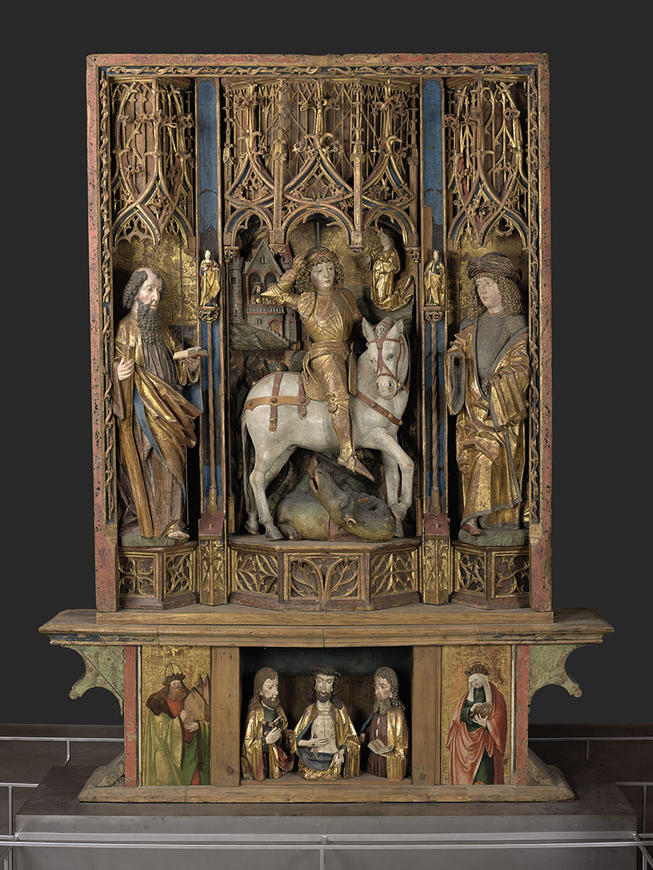The main part of the altarpiece (the central section) illustrates the legend of St. George. As he enters the town of Trebizond, the knight notices that the inhabitants are being terrorised by a dragon. It demands sacrifices of young men, whom it devours! That day, it is the princess of the city that is claimed as a sacrifice. Saint George sets out to fight the monster and pierce it with his spear, which has now disappeared from the altarpiece.
Did you notice the princess and her parents in the background? They are deliberately smaller than St. George, because they are secondary characters. This difference in scale, common in the Middle Ages, makes it possible to highlight the main subject.
On the sides are Saint Andrew and another saint, who is not identified. These stocky statues, with their chubby faces, are clothed in ample garments with angular folds.
Now, look at the predella, the lower part of the altarpiece. The characters, including Christ in the centre, are distinguished by their fine lines and meditative faces. They were probably not made for this altarpiece, but added to it in the XIXth century, together with the painted panels depicting the Emperor Henry Ist, King of Germany and Emperor of the Holy Roman Empire from the early XIth century and his wife Cunegonde. These popular rulers were canonised in the XIIth century.
The shutters which depict them, of later style, cannot have come from the Altarpiece of St. George: they are painted on the reverse. They would have been the shutters of another altarpiece that has now disappeared.
Despite these numerous modifications and reconstructions, this work remains an outstanding example of a sculpted Germanic altarpiece preserved in a museum in France.
(Inventory number: A 343 )
Detail 1 : The image of Christ in the centre is called "Christ as a man of sorrow." It shows Jesus at the moment of the Passion. The raw suffering expressed makes it possible to believe in the humanity of the Son of God. A closer relationship can thus be more easily established with the faithful. Here the hollow and elongated features of the figures accentuate the tragedy.
Detail 2 : The reverse side of the altarpiece, decorated with plant motifs, bears numerous graffiti which have told us about its exact provenance. The work was created for a church dedicated to St. George in the South Tyrol region, which today corresponds to the north of Italy.

The main part of the altarpiece (the central section) illustrates the legend of St. George. As he enters the town of Trebizond, the knight notices that the inhabitants are being terrorised by a dragon. It demands sacrifices of young men, whom it devours! That day, it is the princess of the city that is claimed as a sacrifice. Saint George sets out to fight the monster and pierce it with his spear, which has now disappeared from the altarpiece.
Did you notice the princess and her parents in the background? They are deliberately smaller than St. George, because they are secondary characters. This difference in scale, common in the Middle Ages, makes it possible to highlight the main subject.
On the sides are Saint Andrew and another saint, who is not identified. These stocky statues, with their chubby faces, are clothed in ample garments with angular folds.
Now, look at the predella, the lower part of the altarpiece. The characters, including Christ in the centre, are distinguished by their fine lines and meditative faces. They were probably not made for this altarpiece, but added to it in the XIXth century, together with the painted panels depicting the Emperor Henry Ist, King of Germany and Emperor of the Holy Roman Empire from the early XIth century and his wife Cunegonde. These popular rulers were canonised in the XIIth century.
The shutters which depict them, of later style, cannot have come from the Altarpiece of St. George: they are painted on the reverse. They would have been the shutters of another altarpiece that has now disappeared.
Despite these numerous modifications and reconstructions, this work remains an outstanding example of a sculpted Germanic altarpiece preserved in a museum in France.
(Inventory number: A 343 )
Detail 1 : The image of Christ in the centre is called "Christ as a man of sorrow." It shows Jesus at the moment of the Passion. The raw suffering expressed makes it possible to believe in the humanity of the Son of God. A closer relationship can thus be more easily established with the faithful. Here the hollow and elongated features of the figures accentuate the tragedy.
Detail 2 : The reverse side of the altarpiece, decorated with plant motifs, bears numerous graffiti which have told us about its exact provenance. The work was created for a church dedicated to St. George in the South Tyrol region, which today corresponds to the north of Italy.